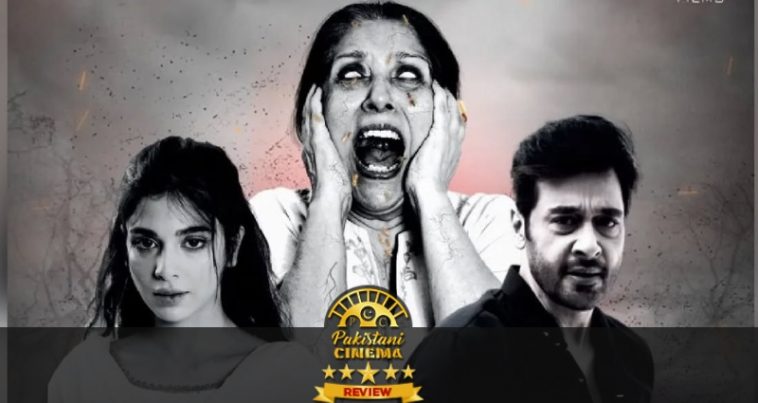At the Premiere of ‘Deemak’, I noticed that there were four posters for horror films being screened right now. ‘Final Destination: Bloodlines’, ‘Bring Her Back’, ‘Siccin 8’ (Turkish Horror film), and ‘Deemak’ were all either running or coming soon. The world’s going through somewhat of a horror renaissance right now.
Did Rafay Rashdi gauge that the Pakistani audience was hungry for some good horror too?
The Story
‘Deemak’ is certainly in the same wheelhouse as ‘The Exorcist’ and ‘Hereditary’, but it is very different from either of those films.
‘Deemak’ tells the story of a house and family dealing with problems familiar to most Pakistani households. However, their problems are made worse by a dark presence; hence the proverbial ‘Deemak’ eroding their peace and happiness.
Faraz, played by Faysal Quraishi, is a devoted son to Kulsoom Begum, played by Samina Peerzada. His wife, Hiba, played by Sonya Hussyn, is a dutiful daughter-in-law and mother, but faces constant berating from her mother-in-law and husband for not doing enough. To make things worse, Kulsoom Begum injures herself falling down a flight of stairs; that too during the COVID-19 pandemic.
All of these problems mount an assault on the family and leave them open to attacks by the dark presence in their home. What follows is possession, breakdowns, and sorrows.
My overall verdict for the film is that it’s worth the watch. This kind of experiment should be done more often in Pakistan. Even at 2 hours of runtime, which is heavy for a horror film, it manages to stay fresh enough. And that’s due to the performances. And that’s where the strength of the film truly lies.
Samina Peerzada and Sonya Hussyn Steal the Show
Samina Peerzada gives what is easily a jewel of a performance. Being handed minimal dialogue, it is her physical performance which does the heavy lifting. In a few instances she reminded me of Toni Collette’s performance in ‘Hereditary’, though a familiar face giving that performance is more haunting for me. She goes through various phases in her performance and invokes each emotion effortlessly. While her voice is a comforting motherly blanket, her eyes invoke fear and chills more than any visual effect.
It’s to be expected though, that talent which has been seasoned through decades can give this sort of effortless performance. However, the real surprise is Sonya Hussyn. She plays the dutiful wife, mother and daughter-in-law, slowly crumbling under pressure.
There is one scene, and you’ll know which one, where she breaks beyond that character into something more and it’s unnerving to say the least. That scene shows Sonya Hussyn harbours a lot of talent if just given the right script and direction. Directors and producers need to give her meatier roles ASAP. Also, she’s never looked lovelier in any role before or since.
Faysal Quraishi, though given the most dialogue, is a secondary character compared to the two female leads. He tries to play the role of the dutiful son and the caring husband but is cracking under the pressure of both expectation and the dark forces around him.
The two cameos in the film, one by Javed Sheikh and the other by Bushra Ansari, are both short and both scene stealers. The seasoned actors are invited on stage like the veterans they are and given impactful roles that drive the story forward. Rafay Rashdi handled them well.
Technical Feats Add Realism to ‘Deemak’
The makeup department has to be lauded for their great work on Samina Peerzada. Her transformation from a motherly figure to a possessed crone is fantastic. It made her performance all the more effective and haunting.
And finally, Rafay Rashdi’s direction shows that he’s a mature filmmaker at work. He’s given his actors time and space to invoke great passion and show restraint wherever either are needed. His ‘Jamun Ka Darakht’ is yet to release in Pakistan but if we compare ‘Deemak’ to to his debut film ‘Thora Jee Le’ (2016), he’s surely come a very long way.
Now to the Negatives
‘Deemak’ has two problems that stick out like sore thumbs. The first is the runtime. At nearly 2 hours, the film tested my patience more than once. Certain shots drag on for far too long and some repetitive dialogues should’ve been cut out. 15 minutes could’ve easily been shaved off the film.
The second gripe I have is with the visual effects. The digital design of the “dark presence” in the film doesn’t have the desired effect. It seems more cartoonish rather than terrifying. In my opinion, using practical effects to portray dark forces would’ve worked out better, with an overlay of digital effects if needed. This is demonstrated brilliantly in one scene of the film near the end.
When ‘The Exorcist’ was released in Pakistan, the story goes that boys used to dare each other to watch the midnight screening and then walk home alone. This was the most terrifying film ever made after all.
Since then, the experiment has been repeated over and over and very few have measured up to the original. While I did feel some chills during ‘Deemak’, I won’t say it measures up to the best. But it’s definitely a great start. There’s a lot to be gleaned from Rafay Rashdi’s experiment in the dark arts.



Comments
0 comments